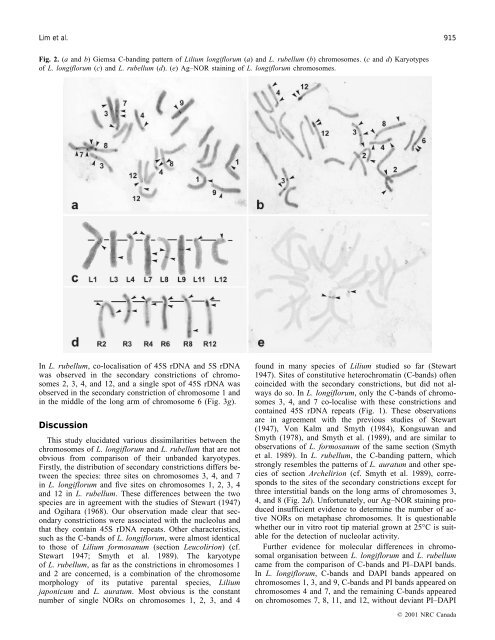Karyotype analysis of Lilium longiflorum and ... - Lilium Breeding
Karyotype analysis of Lilium longiflorum and ... - Lilium Breeding
Karyotype analysis of Lilium longiflorum and ... - Lilium Breeding
Create successful ePaper yourself
Turn your PDF publications into a flip-book with our unique Google optimized e-Paper software.
Lim et al. 915<br />
Fig. 2. (a <strong>and</strong> b) Giemsa C-b<strong>and</strong>ing pattern <strong>of</strong> <strong>Lilium</strong> <strong>longiflorum</strong> (a) <strong>and</strong> L. rubellum (b) chromosomes. (c <strong>and</strong> d) <strong>Karyotype</strong>s<br />
<strong>of</strong> L. <strong>longiflorum</strong> (c) <strong>and</strong> L. rubellum (d). (e) Ag–NOR staining <strong>of</strong> L. <strong>longiflorum</strong> chromosomes.<br />
In L. rubellum, co-localisation <strong>of</strong> 45S rDNA <strong>and</strong> 5S rDNA<br />
was observed in the secondary constrictions <strong>of</strong> chromosomes<br />
2, 3, 4, <strong>and</strong> 12, <strong>and</strong> a single spot <strong>of</strong> 45S rDNA was<br />
observed in the secondary constriction <strong>of</strong> chromosome 1 <strong>and</strong><br />
in the middle <strong>of</strong> the long arm <strong>of</strong> chromosome 6 (Fig. 3g).<br />
Discussion<br />
This study elucidated various dissimilarities between the<br />
chromosomes <strong>of</strong> L. <strong>longiflorum</strong> <strong>and</strong> L. rubellum that are not<br />
obvious from comparison <strong>of</strong> their unb<strong>and</strong>ed karyotypes.<br />
Firstly, the distribution <strong>of</strong> secondary constrictions differs between<br />
the species: three sites on chromosomes 3, 4, <strong>and</strong> 7<br />
in L. <strong>longiflorum</strong> <strong>and</strong> five sites on chromosomes 1, 2, 3, 4<br />
<strong>and</strong> 12 in L. rubellum. These differences between the two<br />
species are in agreement with the studies <strong>of</strong> Stewart (1947)<br />
<strong>and</strong> Ogihara (1968). Our observation made clear that secondary<br />
constrictions were associated with the nucleolus <strong>and</strong><br />
that they contain 45S rDNA repeats. Other characteristics,<br />
such as the C-b<strong>and</strong>s <strong>of</strong> L. <strong>longiflorum</strong>, were almost identical<br />
to those <strong>of</strong> <strong>Lilium</strong> formosanum (section Leucolirion) (cf.<br />
Stewart 1947; Smyth et al. 1989). The karyotype<br />
<strong>of</strong> L. rubellum, as far as the constrictions in chromosomes 1<br />
<strong>and</strong> 2 are concerned, is a combination <strong>of</strong> the chromosome<br />
morphology <strong>of</strong> its putative parental species, <strong>Lilium</strong><br />
japonicum <strong>and</strong> L. auratum. Most obvious is the constant<br />
number <strong>of</strong> single NORs on chromosomes 1, 2, 3, <strong>and</strong> 4<br />
found in many species <strong>of</strong> <strong>Lilium</strong> studied so far (Stewart<br />
1947). Sites <strong>of</strong> constitutive heterochromatin (C-b<strong>and</strong>s) <strong>of</strong>ten<br />
coincided with the secondary constrictions, but did not always<br />
do so. In L. <strong>longiflorum</strong>, only the C-b<strong>and</strong>s <strong>of</strong> chromosomes<br />
3, 4, <strong>and</strong> 7 co-localise with these constrictions <strong>and</strong><br />
contained 45S rDNA repeats (Fig. 1). These observations<br />
are in agreement with the previous studies <strong>of</strong> Stewart<br />
(1947), Von Kalm <strong>and</strong> Smyth (1984), Kongsuwan <strong>and</strong><br />
Smyth (1978), <strong>and</strong> Smyth et al. (1989), <strong>and</strong> are similar to<br />
observations <strong>of</strong> L. formosanum <strong>of</strong> the same section (Smyth<br />
et al. 1989). In L. rubellum, the C-b<strong>and</strong>ing pattern, which<br />
strongly resembles the patterns <strong>of</strong> L. auratum <strong>and</strong> other species<br />
<strong>of</strong> section Archelirion (cf. Smyth et al. 1989), corresponds<br />
to the sites <strong>of</strong> the secondary constrictions except for<br />
three interstitial b<strong>and</strong>s on the long arms <strong>of</strong> chromosomes 3,<br />
4, <strong>and</strong> 8 (Fig. 2d). Unfortunately, our Ag–NOR staining produced<br />
insufficient evidence to determine the number <strong>of</strong> active<br />
NORs on metaphase chromosomes. It is questionable<br />
whether our in vitro root tip material grown at 25°C is suitable<br />
for the detection <strong>of</strong> nucleolar activity.<br />
Further evidence for molecular differences in chromosomal<br />
organisation between L. <strong>longiflorum</strong> <strong>and</strong> L. rubellum<br />
came from the comparison <strong>of</strong> C-b<strong>and</strong>s <strong>and</strong> PI–DAPI b<strong>and</strong>s.<br />
In L. <strong>longiflorum</strong>, C-b<strong>and</strong>s <strong>and</strong> DAPI b<strong>and</strong>s appeared on<br />
chromosomes 1, 3, <strong>and</strong> 9, C-b<strong>and</strong>s <strong>and</strong> PI b<strong>and</strong>s appeared on<br />
chromosomes 4 <strong>and</strong> 7, <strong>and</strong> the remaining C-b<strong>and</strong>s appeared<br />
on chromosomes 7, 8, 11, <strong>and</strong> 12, without deviant PI–DAPI<br />
© 2001 NRC Canada














